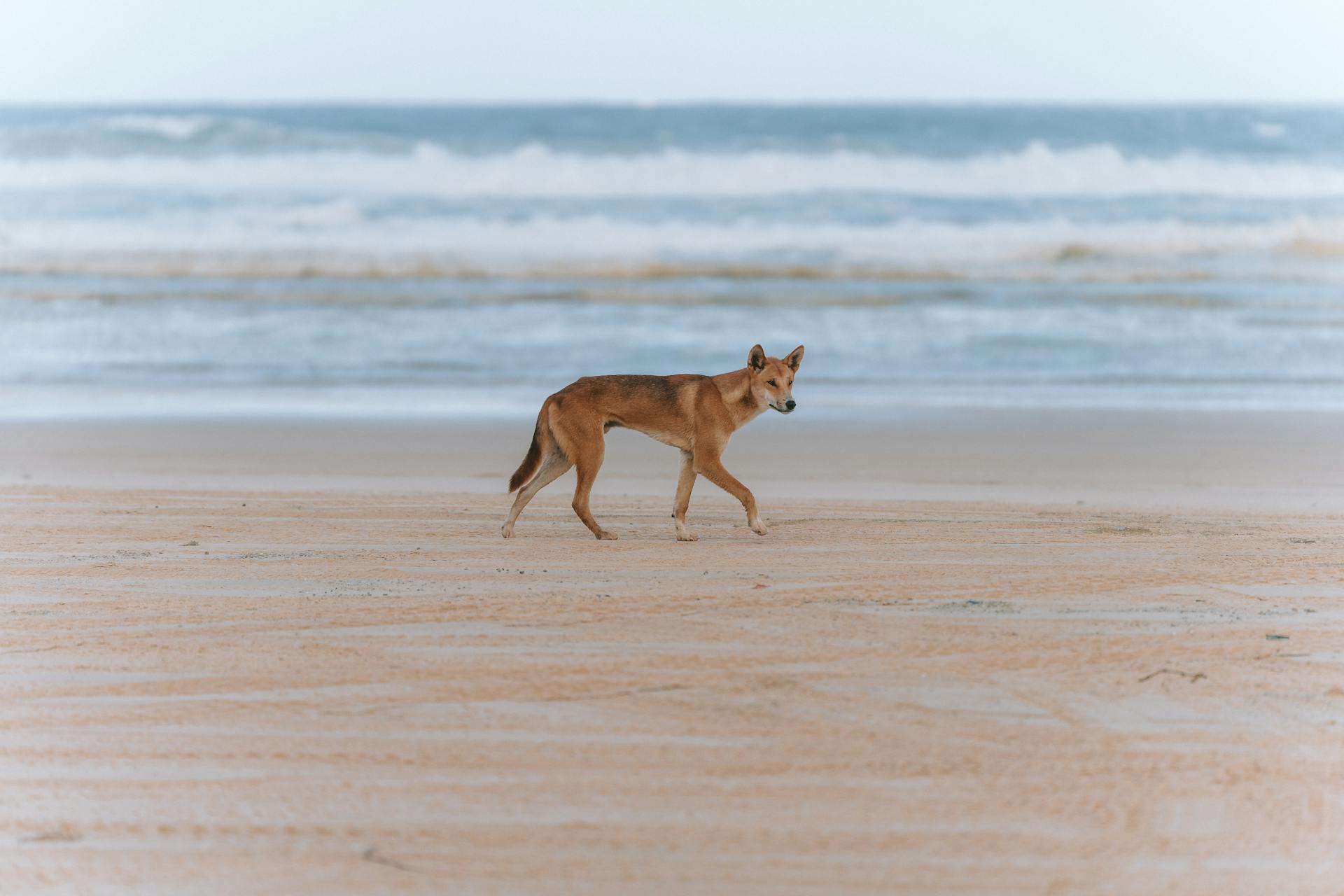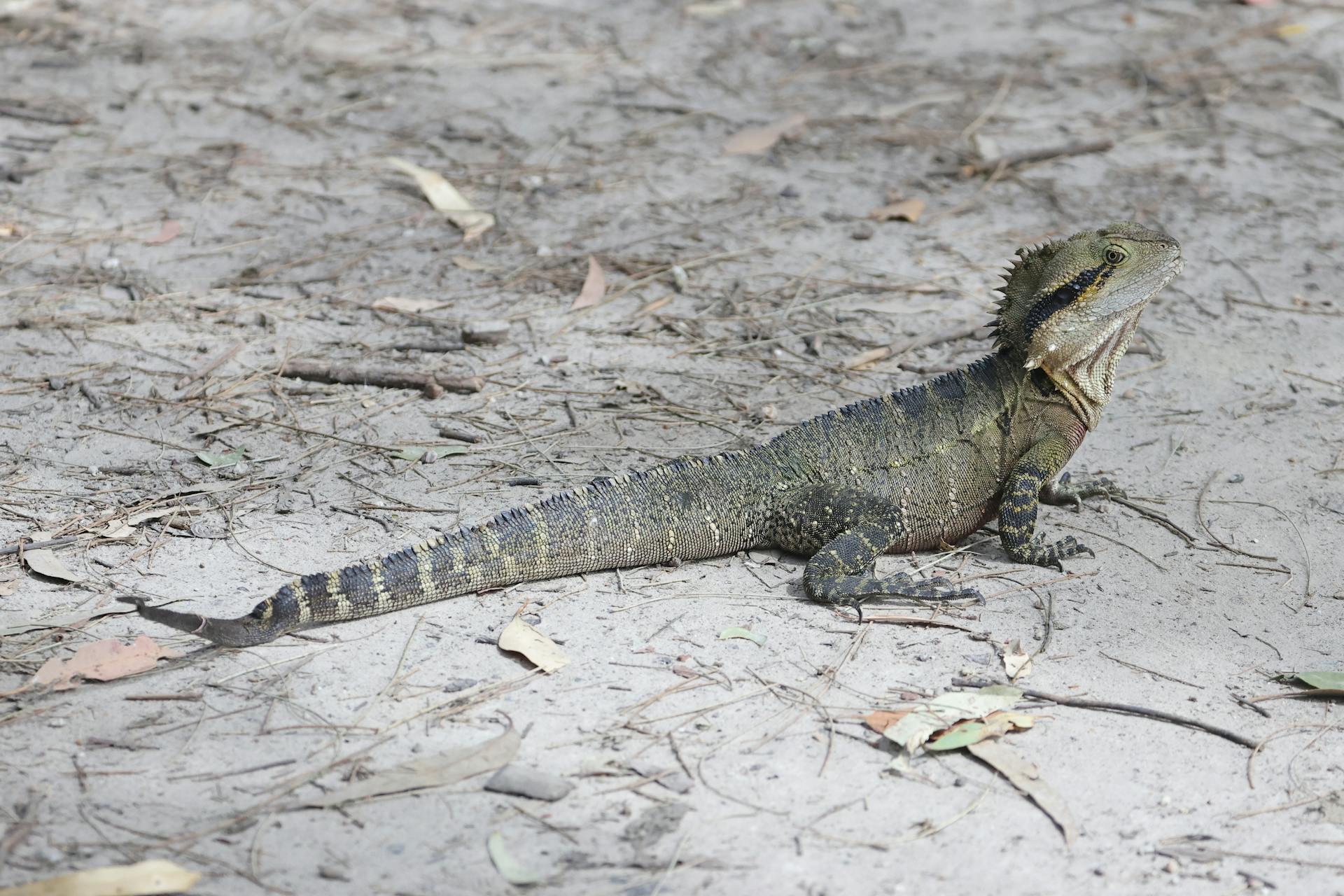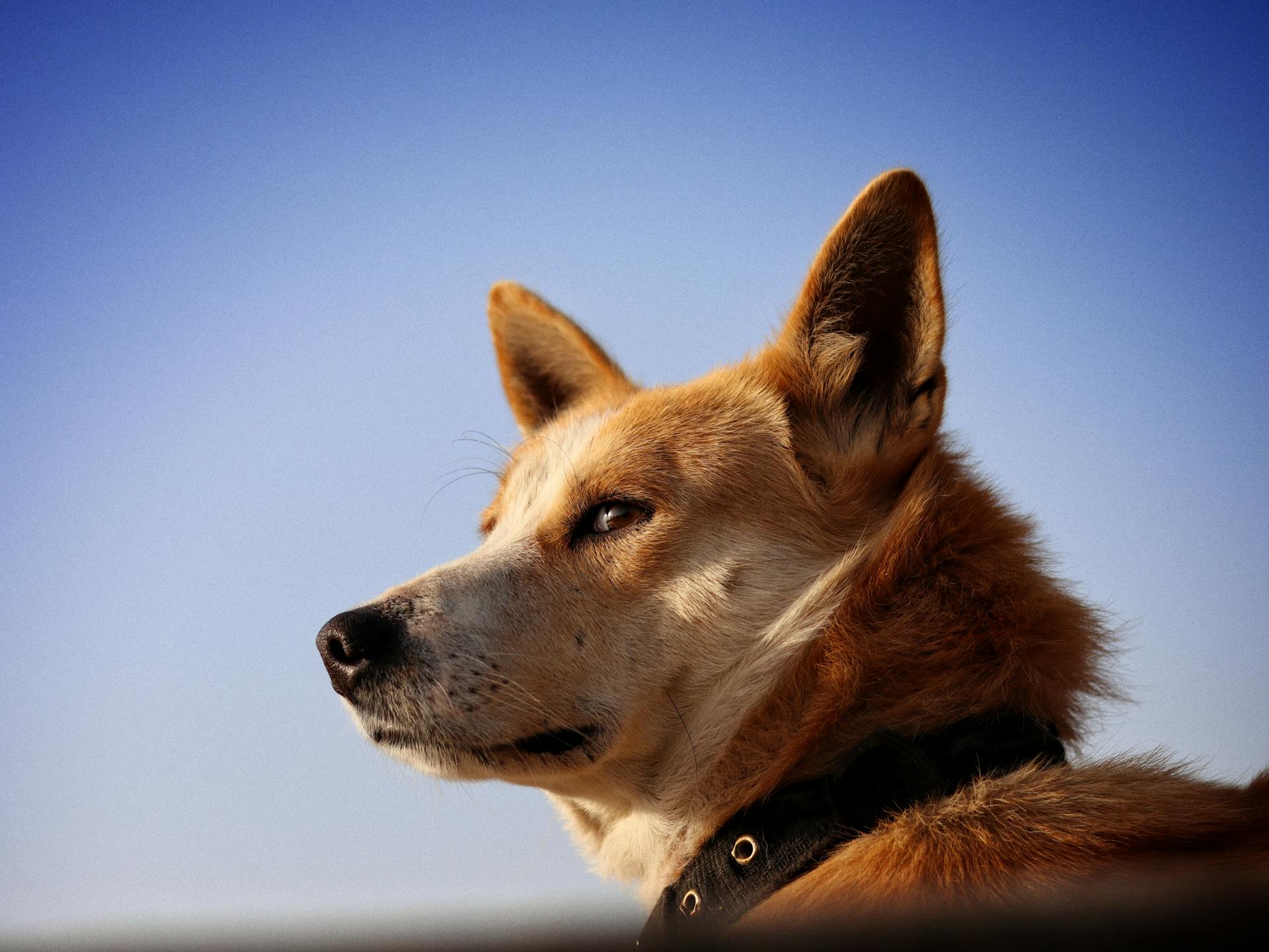
Dingos and domestic dogs have been interbreeding for thousands of years, resulting in a unique hybrid species. This phenomenon has been extensively studied, revealing fascinating insights into the genetic and ecological dynamics at play.
Research suggests that the dingo dog hybrid, also known as a "dingo-dog cross", can exhibit a range of characteristics from both parent species. In some cases, the hybrid may display a strong resemblance to its dingo parent, while in others, it may resemble its domestic dog parent.
Studies have shown that dingos and domestic dogs can interbreed successfully, producing viable offspring. This is likely due to the fact that both species share a recent common ancestor.
Dingo Distribution and Genetics
Dingos are native to Australia and can be found in the wild across the country, with a focus in the Outback region.
Their distribution is influenced by their ability to adapt to different environments, from tropical rainforests to arid deserts.
Dingos are highly social animals and are often found in packs.
Genetically, dingos are more closely related to wolves than domestic dogs, sharing a common ancestor.
Studies have shown that dingos have a unique genetic makeup that sets them apart from other canines.
The genetic analysis of dingos reveals that they have a low genetic diversity, likely due to their isolation in Australia for thousands of years.
This genetic uniqueness is a key factor in the ongoing debate about the origins of the dingo.
Understanding Hybridization
Hybridization between dingos and domestic dogs is a significant issue in Australia, with extensive interbreeding occurring throughout the country.
Dingos and dogs can hybridize in both captivity and the wild, resulting in partially fertile offspring.
The IUCN rates the dingo as vulnerable, mainly due to this extensive hybridization with domestic dogs.
In fact, hybrids exist in all dingo populations worldwide, and the external phenotypic characters of many hybrids are indistinguishable from pure dingoes.
Dingos, dogs, wolves, and golden jackals all have the same chromosome number, which is 2n=78.
This extensive hybridization threatens the continued existence of the dingo as an entity distinct from the ordinary dog.
For your interest: Dog Hybrids
Degree of Interbreeding
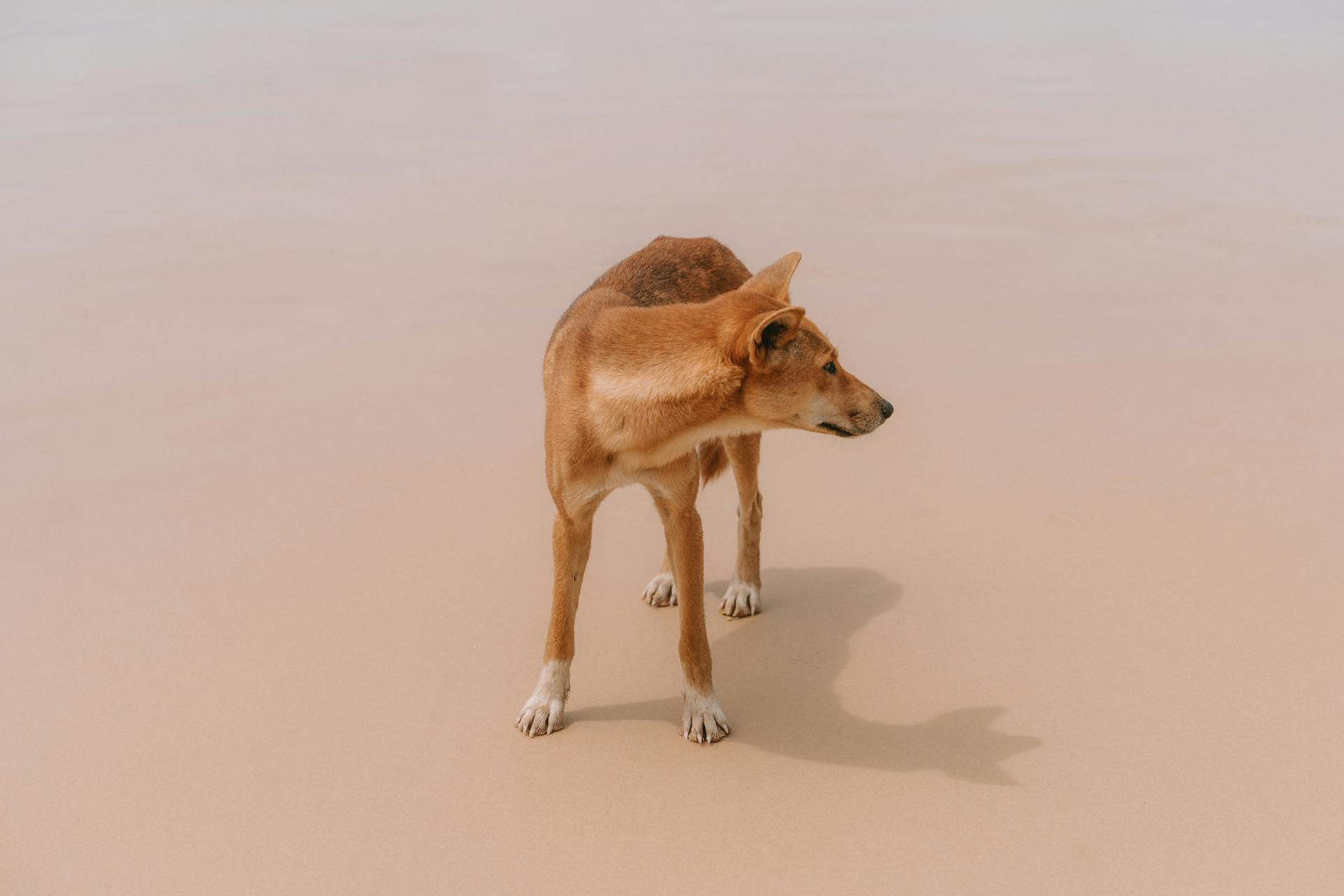
Hybridization can occur between closely related species, but the degree of interbreeding can vary greatly.
In some cases, hybrids can be fertile and produce viable offspring, whereas in others, they may be sterile or exhibit reduced fertility.
The extent of interbreeding is influenced by genetic differences between the parent species.
Genetic differences of 5% or less can lead to successful hybridization, while differences above 20% can result in reduced fertility or sterility.
For example, the liger, a cross between a lion and a tiger, is generally sterile due to significant genetic differences between the two parent species.
In contrast, the mule, a hybrid of a male donkey and a female horse, is often fertile and can produce offspring.
Causes
European domestic dogs arrived in Australia in the 18th century, during the European colonization. This marked the beginning of a significant change in the country's ecosystem.
The introduction of European domestic dogs led to their dispersal into the wild, both intentionally and unintentionally, resulting in the formation of feral populations. These populations thrived in areas where the native dingo numbers had been severely reduced due to human intervention.
Additional reading: European Wolfdog
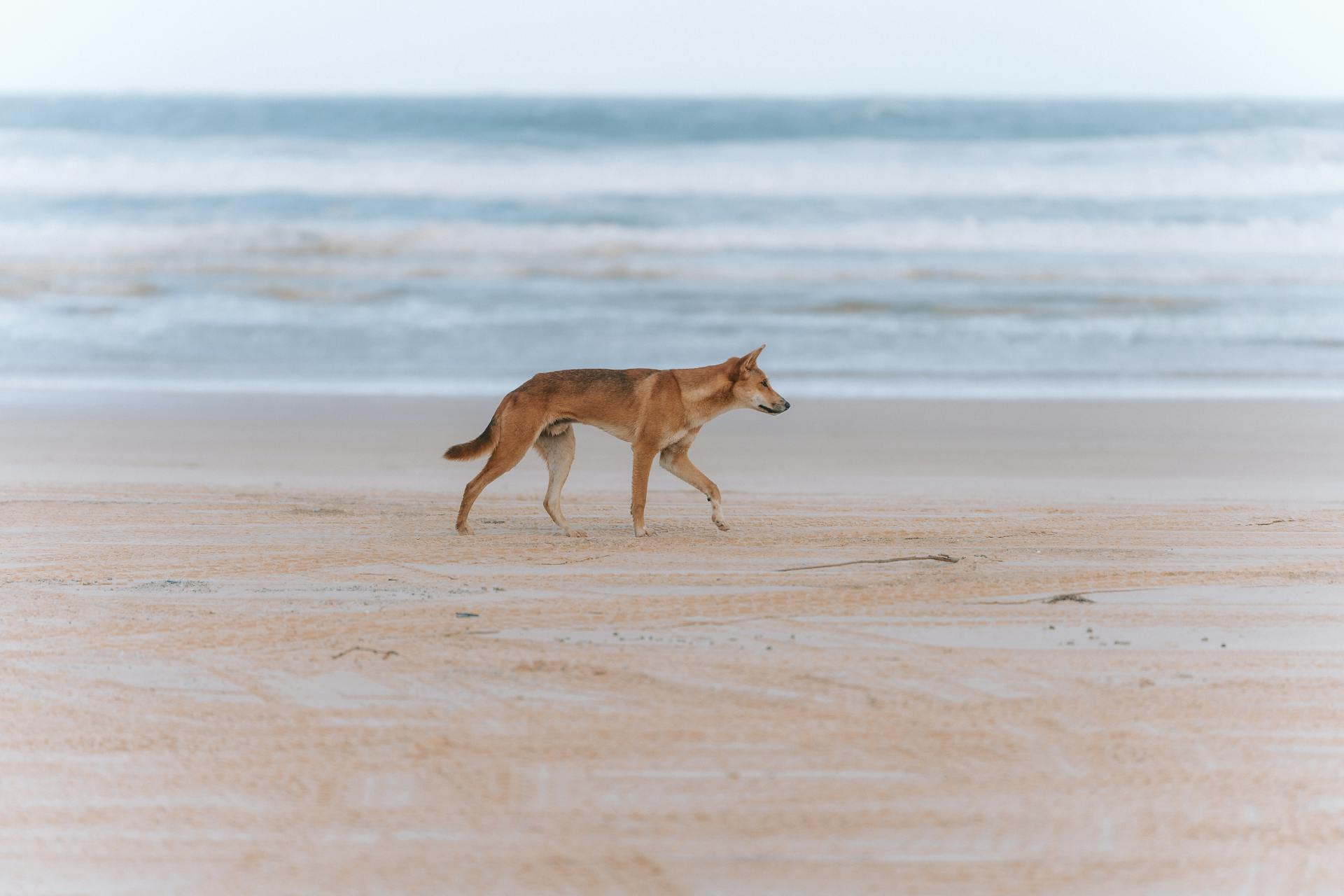
Farming and grazing activities in the 19th century further contributed to the spread of domestic dogs, both as pets and as feral animals. This expansion of domestic dog populations likely increased the opportunities for interbreeding with native dingoes.
Interbreeding between domestic dogs and dingoes has probably been occurring since the arrival of domestic dogs in 1788.
Possible Changes in Behavior and Biology
Hybridization can lead to changes in behavior. This is often seen in the offspring of two different species that have been bred together, such as the mule, which is sterile and has a unique temperament.
Some hybrid animals may exhibit increased aggression due to the combination of their parents' traits. For example, the Bengal cat, a cross between a domestic cat and an Asian leopard cat, can be more energetic and demanding than either parent.
Hybridization can also result in changes to an organism's physical characteristics. The liger, a cross between a lion and a tiger, is a prime example, often growing larger than either parent species.
In some cases, hybridization can even lead to changes in an organism's biology. For instance, the mule has a different number of chromosomes than either its horse or donkey parents, making it sterile.
A fresh viewpoint: Wolf Cross Breed Dog
Importance of Hybridisation
Hybridisation is a major threat to the survival of pure dingoes in the wild.
In just 50 years, the "pure" dingo is expected to have disappeared in the wild, and it's no longer possible to preserve them.
Genetic analyses and observations over several years indicate that interbreeding with domestic dogs is the main culprit behind this decline.
Laurie Corbett, a renowned dingo researcher, predicts that there will be no more "pure" dingoes in the wild in Victoria in just 20 years.
The president of the Dingo Conservation Association, Barry Oakman, warns that without measures to prevent it, the "pure" dingo will be extinct in the wild in 30 years in New South Wales, possibly sooner.
The increasing number of genes from domestic dogs will lead to the extinction of the dingo as a separate subspecies on the Australian continent by 2100.
Worth a look: Shiba Inu 1 Cent
Opinions on Hybridisation
Hybridisation is a powerful tool for creating new and improved plants. In fact, many modern crops are the result of hybridisation, such as the high-yielding wheat varieties that have increased food production globally.

Some people believe that hybridisation can help solve the world's food crisis by increasing crop yields and improving disease resistance. This is evident in the example of the "Golden Rice" project, which aims to create a rice variety that is rich in vitamin A to combat malnutrition.
However, others argue that hybridisation can have unintended consequences, such as reducing genetic diversity and making crops more vulnerable to pests and diseases. This is a concern, as seen in the example of the " terminator gene" that was introduced into some crops to prevent seed saving, but ultimately led to reduced crop yields and decreased farmer control.
Despite these concerns, many farmers and scientists believe that the benefits of hybridisation outweigh the risks. For example, the use of hybridisation in the development of drought-tolerant crops has shown great promise in areas where water is scarce.
Identification and Management
Many pure dingoes and dingo-dominant backcrosses are being killed under the assumption that all dingoes are wild dogs. This is because the term "wild dog" obscures the reality of dingo hybridisation and is used to justify lethal control measures.
Discover more: Wild Dog vs Domestic Dog
Dingoes play a crucial role as apex predators in maintaining ecosystem function and biodiversity. They're not a pest in all contexts, especially in environments where they help control populations of kangaroos, foxes, and feral cats.
Lethal control methods, particularly during dingo breeding season, may inadvertently increase the risk of hybridisation by reducing the availability of pure dingo mates.
Canine Confusion: NSW 'Wild Dogs' Identified as Dingoes
In New South Wales, most of the so-called wild dogs killed to protect livestock are actually dingoes or dingo-hybrids.
Between 9% and 23% of the "wild dogs" in NSW have only dingo ancestry, according to a study by researchers at the University of New South Wales.
Less than 1% of the DNA samples had no dingo ancestry at all, which challenges the notion that most dingo populations had died out in the state.
Dingoes are Australia's only native canid and have been in the country for about 5,000 years.
Here's an interesting read: New York Bernese Mountain Dog Breeders
Researchers say the focus on wild dogs has been to protect livestock producers, but there's no plan to protect dingo populations.
There are still quite a few pure dingoes out there, and almost no dogs, according to Prof Mike Letnic, a co-author of the study.
The researchers identified three hotspots in Port Macquarie, Myall Lakes, and the Washpool National Park, where there were more pure dingos than expected.
We need to consider our terminology because calling them wild dogs is misleading, says Dr Kylie Cairns, lead author of the study.
A different take: Dog Food for Dogs with No Teeth
Informing Evidence-Based Management
Dingoes are being killed under the name "wild dog", but this term obscures the reality that many pure dingoes and dingo-dominant backcrosses are being targeted.
In Australia, the term "wild dog" is widely used in policy, but it's a misnomer that fails to distinguish between dingoes, dingo-hybrids, and feral domestic dogs.
Environments without dingoes can get overrun by kangaroos, foxes, and feral cats that threaten other native animals and can change vegetation significantly.
Broaden your view: Long Term Dog Boarding San Antonio
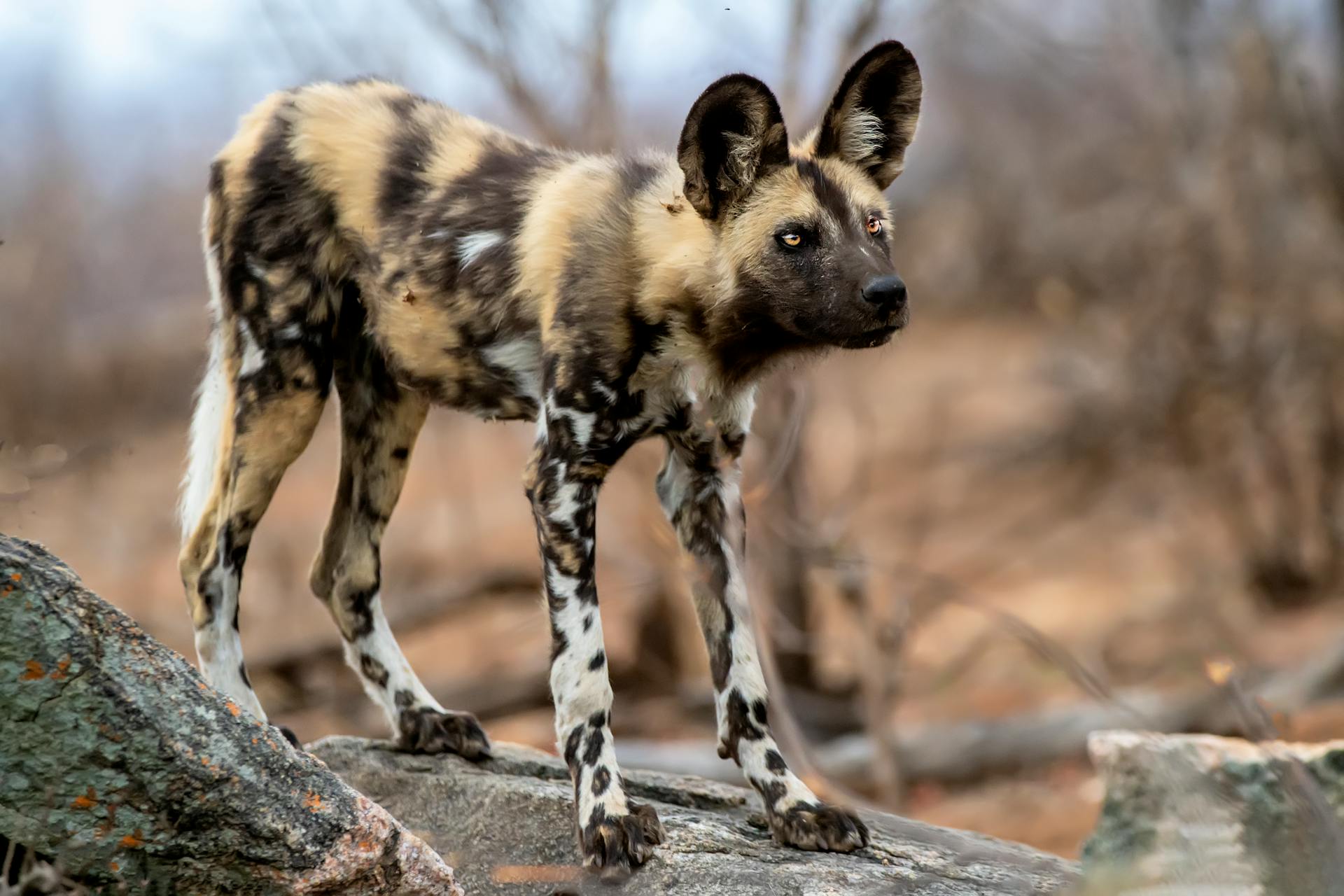
Dingoes play a crucial role as apex predators in maintaining ecosystem function and biodiversity, but lethal control methods may inadvertently increase the risk of hybridisation by reducing the availability of pure dingo mates.
Lethal control methods, particularly during dingo breeding season, may inadvertently increase the risk of hybridisation by reducing the availability of pure dingo mates.
The researchers suggest that the definition of "dingoes" in conservation policy should be revised to include historical dingo backcrosses with 93 per cent or more dingo ancestry and distinguish them from "feral domestic dogs".
Additional reading: Pure White Northern Inuit Dog
Problems in Identification
One of the biggest challenges in identification is the lack of clear criteria for distinguishing between similar species. This can lead to misidentification and incorrect management practices.
Some species, like the red wolf and the coyote, are notoriously difficult to tell apart. The red wolf's howl is often described as a low-pitched, mournful sound.
The similarity in appearance between the eastern box turtle and the Gulf Coast box turtle can also cause confusion. The eastern box turtle has a dome-shaped shell, while the Gulf Coast box turtle has a more rounded shell.
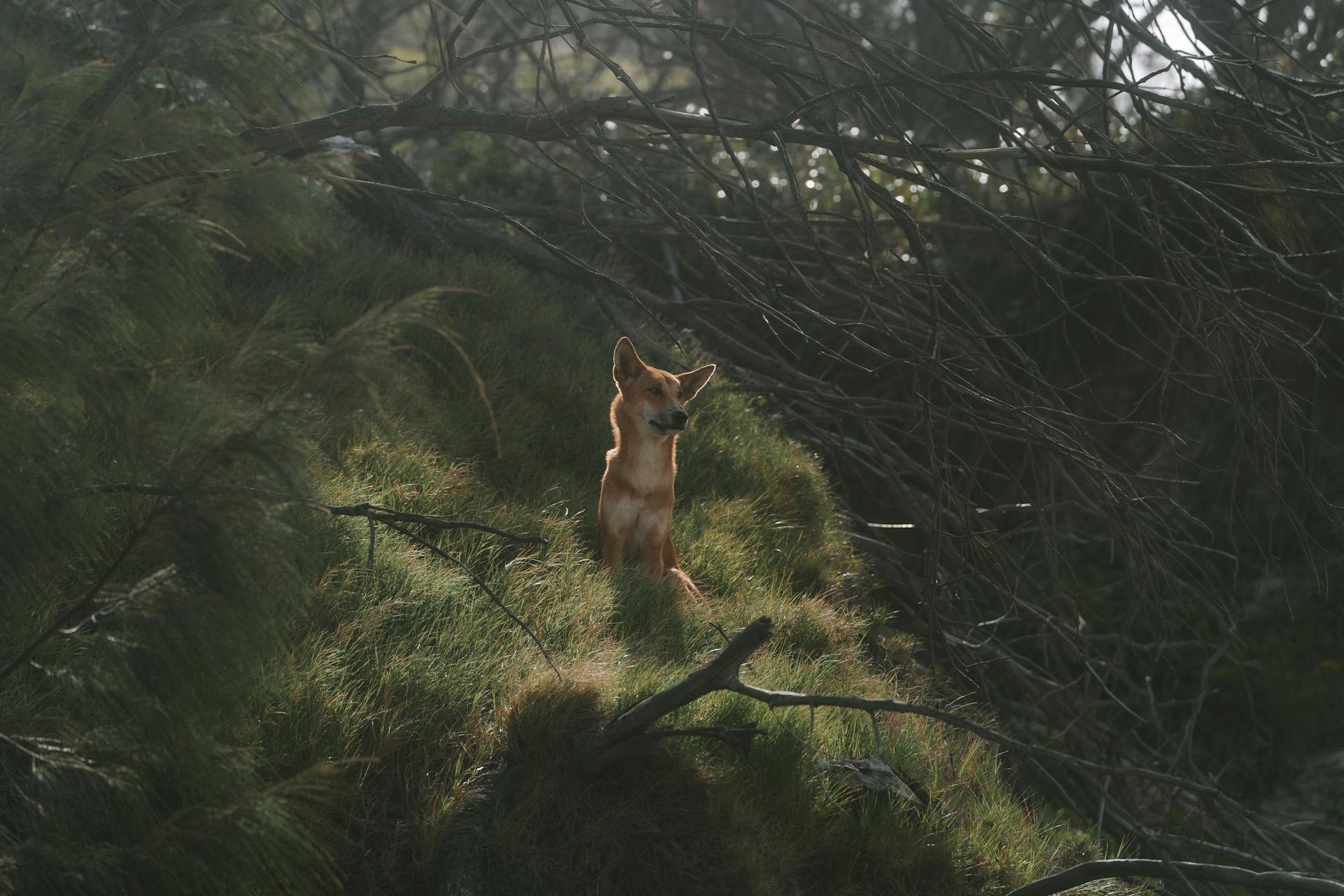
The presence of a unique marking or pattern can help identify some species, but not all. For example, the western pond turtle has a distinctive yellow or orange stripe on its neck.
The lack of a clear identification method can lead to overestimation of a species' population size. This can result in inadequate conservation efforts.
Ecological Impact
The ecological impact of dingo dog hybrids is a topic of interest, but also somewhat unclear. It's not known how these hybrids would affect the predation pressure on other species if pure dingoes were to disappear.
Research on this topic is rare, but it's considered probable that the dynamics of various ecosystems won't be disturbed. For example, bush rats have been exposed to dingoes for thousands of years and it's unlikely that problems would arise from hybrids.
In the Kosciuszko national park, local dogs were observed with home ranges similar to those of Southeast Australian dingoes. They also showed a preference for living prey, which reduced the effectiveness of baits.
Intriguing read: Pictures of Wolf Hybrids
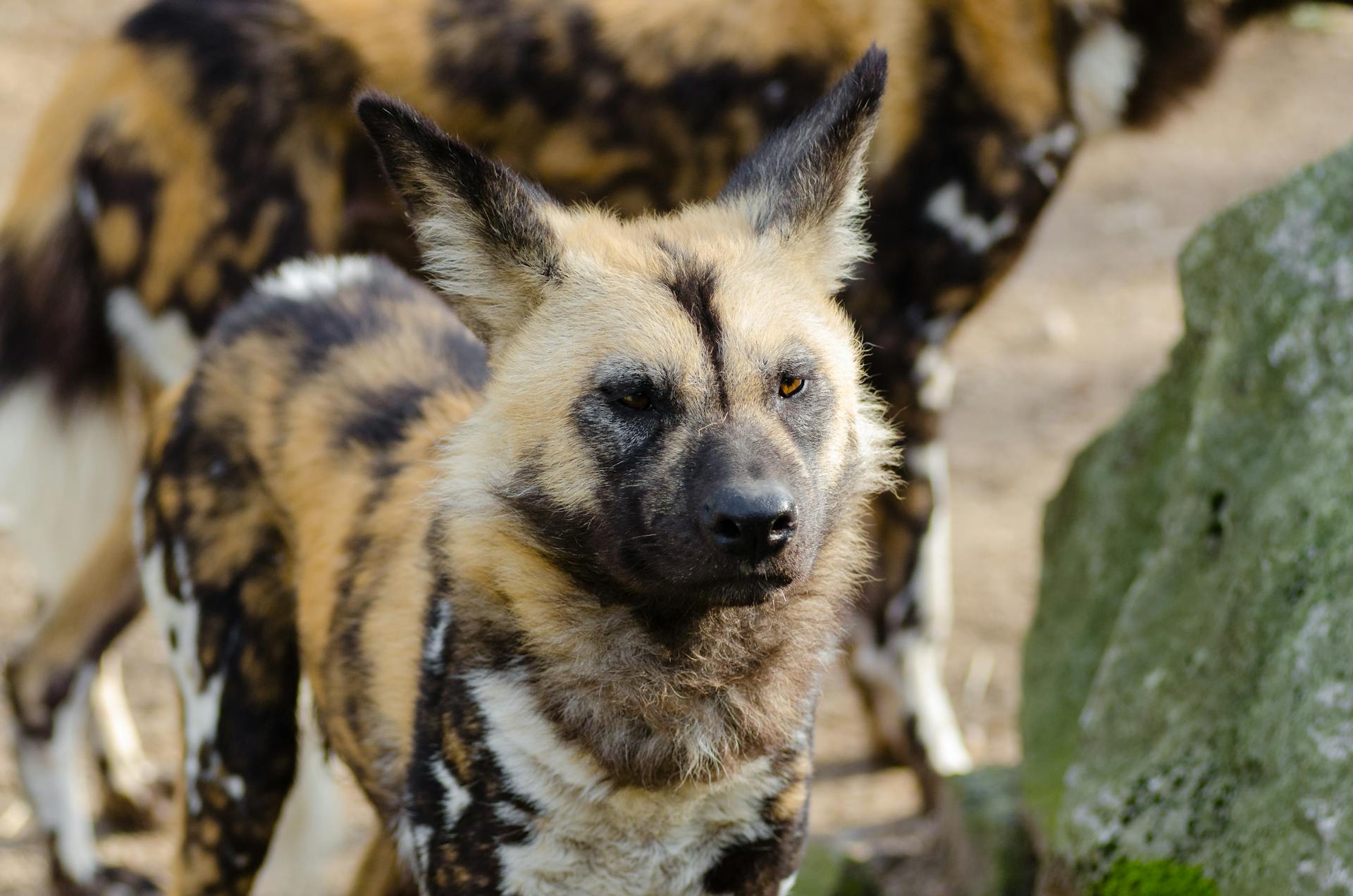
The main prey of these dogs consisted of red-necked wallabies, swamp wallabies, grey kangaroos, common wombats, common brushtail possums, and European rabbits. A big hybrid population was found to exert significant pressure on swamp wallabies and control rabbit populations.
A study in the Kosciuszko National Park found that wild dogs had about 75-80% content of dingo genes and filled the role of the apex predator. These hybrids hunted alone as well as in coordinated packs, similar to "pure" dingoes.
Here's a list of some of the ecosystems where dingo dog hybrids have been found to play an important ecological role:
- Kosciuszko National Park
- Blue Mountains
- Namadgi-national park
In these ecosystems, hybrids have been found to control kangaroo numbers and fill the place of the apex predator.
Mammalian Hybrids
The dingo is a distinctive type of canid that has resided in the Australasian region for thousands of years.
Dingoes and dogs can interbreed extensively throughout most of Australia, and in fact, hybrids exist in all dingo populations worldwide.
Dingo populations are difficult to estimate because many hybrids have indistinguishable external characteristics from pure dingoes.
Dingoes and dogs can also co-occur and hybridize in Indonesia, New Guinea, and southeast Asia.
Dogs, dingoes, wolves, and golden jackals all share the same chromosome number, which is 2n=78.
The IUCN rates the dingo as vulnerable, mainly due to its extensive hybridization with the domestic dog.
In captivity, dog-dingo hybrids have been produced many times and are at least partially fertile in both sexes.
The dingo's conservation value is still recognized despite its hybridization with domestic dogs.
A different take: Strange Dog Hybrids
Frequently Asked Questions
How do I tell if my dog is a dingo?
To identify a dingo, look for almond-shaped eyes, pointed ears, a sleek body, and a low-set bushy tail, as well as a coat that can range from white to ginger red to tan and black. If your dog matches these distinctive physical characteristics, it may be a dingo, but further identification by a professional is usually necessary.
Can a dingo be a pet dog?
While dingoes can make loving companions, they require specialized care that's often more time-consuming and expensive than caring for a traditional dog. If you're considering a dingo as a pet, it's essential to carefully weigh the unique challenges involved.
What dog is crossed with a dingo?
The Australian Cattle Dog's ancestor, the Hall's Heeler, was developed from a cross between the dingo and the smooth-coated Scottish Collie. This unique heritage gives the ACD its distinctive characteristics and abilities.
Sources
- https://pestsmart.org.au/toolkit-resource/distribution-of-pure-dingoes-and-dingo-dog-hybrids-in-australia/
- https://www.unsw.edu.au/newsroom/news/2023/05/new-dna-testing-technology-shows-majority-of-wild-dingoes-are-pure-not-hybrids
- http://www.macroevolution.net/dog-dingo-hybrids.html
- https://www.theguardian.com/environment/2019/nov/03/canine-confusion-nsw-wild-dogs-found-to-be-dingoes-or-dingo-hybrids
- https://en.wikipedia.org/wiki/Dingo%E2%80%93dog_hybrid
Featured Images: pexels.com
